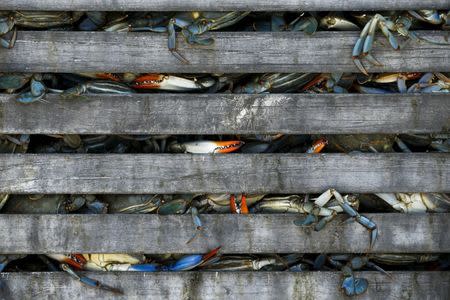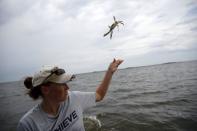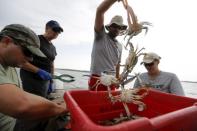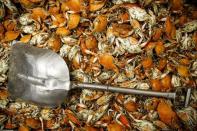Chesapeake crabbers face changing workforce, murky future
By Ayesha Rascoe WASHINGTON (Reuters) - Morgan Tolley is a third generation crab processor working on the shores of the Chesapeake Bay, but he's worried that his industry may be under threat as more and more young people shun the traditional family-oriented trade. The A.E. Phillips crab picking house Tolley manages in Fishing Creek, Maryland, relies on crabs harvested by the "watermen" of the Bay. "It's passed down from generation to generation, that's how you learn to become a waterman. Not everybody knows how to fish a trotline or bait a crab pot," Tolley said. As more people grow up and leave the small rural shore towns known for crab fishing in search of job opportunities with less- erratic pay, the industry's future is in doubt. A shrinking workforce on the water is just one threat to the Chesapeake Bay's iconic blue crab fisheries. The local sector must also contend with reduced crab numbers, environmental issues and an increasingly global agricultural market. Blue crabs are found up and down the East Coast, from Nova Scotia to Argentina. But the crustaceans have long been synonymous with the Bay, the largest U.S. estuary, with a surface area of 4,480 square miles. The crab population crashed in the 1990s and early 2000s, forcing some companies to begin importing crab meat from Asia. Matthew Ogburn, an ecologist with the Smithsonian Environmental Research Center's Fish and Invertebrate Ecology Lab, said researchers found that over-harvesting of crabs may have led to the declines. Regulators have tried to correct this by limiting the harvest of female crabs. Most of the restrictions were put in place in 2008. Since they mate only once and migrate to the mouth of the Bay to reproduce, females captured by fishermen often have not yet produced offspring. Crabs that are harvested must meet a certain shell width. The minimum size requirements vary based on sex of the crab, the season and other criteria. "Protections of females are really important, but they can't guarantee a high catch," Ogburn said, noting that other factors like weather patterns and pollution also play a role. In 2014, watermen harvested 35 million pounds of crabs from the Chesapeake, the lowest level recorded in 25 years and down from highs of nearly 120 million pounds in the mid-1990s, according to the Chesapeake Bay Stock Assessment Committee. While crab populations have changed, the workforce that processes crab meat in picking houses has also been transformed as companies become more reliant on immigrant labor. The Phillips crab picking house, which supplies the locally famous Phillips Seafood Restaurants, now hires mainly Mexican employees through the U.S. H2B visa program for seasonal guest workers. Local workers do not want the tough manual jobs in picking houses anymore, Tolley said, noting that the crab processing industry has had a difficult time securing the limited amount of guest worker visas issued by the federal government. Lawsuits challenging the government's management of H2B visas have recently disrupted the program, with a court ruling briefly forcing authorities to stop processing applications in March. Labor Department statistics show that seafood companies in Maryland eventually received visas for at least 420 seasonal workers this year. (Additional reporting by Jonathan Ernst; Editing by Kevin Drawbaugh and Dan Grebler)

 Yahoo News
Yahoo News 









